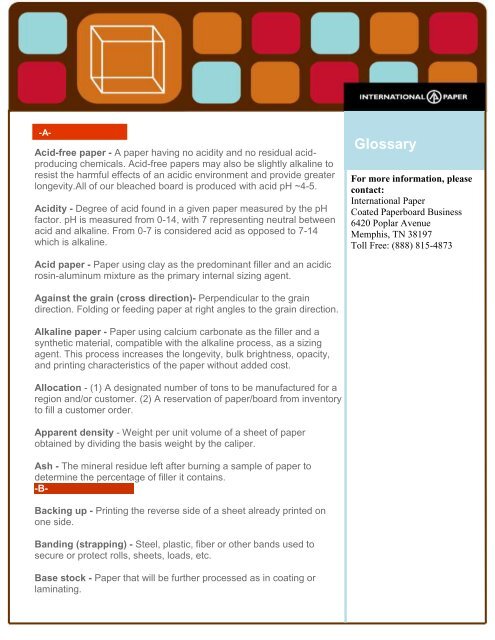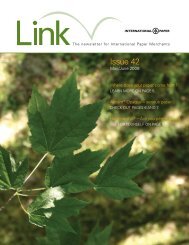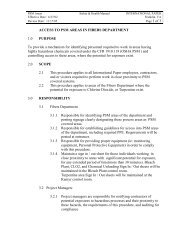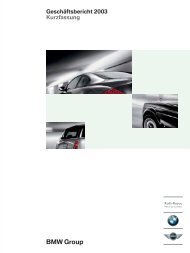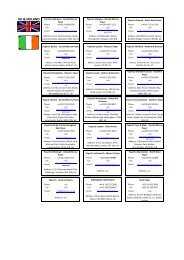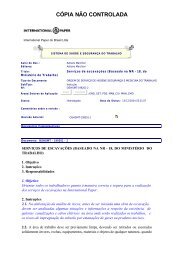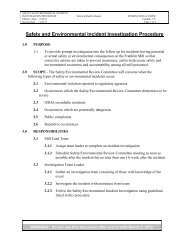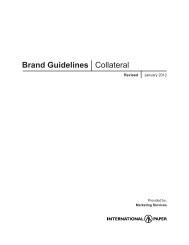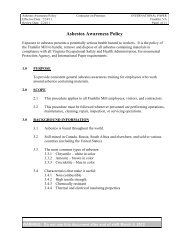Glossary - International Paper
Glossary - International Paper
Glossary - International Paper
Create successful ePaper yourself
Turn your PDF publications into a flip-book with our unique Google optimized e-Paper software.
-A-<br />
Acid-free paper - A paper having no acidity and no residual acidproducing<br />
chemicals. Acid-free papers may also be slightly alkaline to<br />
resist the harmful effects of an acidic environment and provide greater<br />
longevity.All of our bleached board is produced with acid pH ~4-5.<br />
Acidity - Degree of acid found in a given paper measured by the pH<br />
factor. pH is measured from 0-14, with 7 representing neutral between<br />
acid and alkaline. From 0-7 is considered acid as opposed to 7-14<br />
which is alkaline.<br />
Acid paper - <strong>Paper</strong> using clay as the predominant filler and an acidic<br />
rosin-aluminum mixture as the primary internal sizing agent.<br />
Against the grain (cross direction)- Perpendicular to the grain<br />
direction. Folding or feeding paper at right angles to the grain direction.<br />
Alkaline paper - <strong>Paper</strong> using calcium carbonate as the filler and a<br />
synthetic material, compatible with the alkaline process, as a sizing<br />
agent. This process increases the longevity, bulk brightness, opacity,<br />
and printing characteristics of the paper without added cost.<br />
Allocation - (1) A designated number of tons to be manufactured for a<br />
region and/or customer. (2) A reservation of paper/board from inventory<br />
to fill a customer order.<br />
Apparent density - Weight per unit volume of a sheet of paper<br />
obtained by dividing the basis weight by the caliper.<br />
Ash - The mineral residue left after burning a sample of paper to<br />
determine the percentage of filler it contains.<br />
-B-<br />
Backing up - Printing the reverse side of a sheet already printed on<br />
one side.<br />
Banding (strapping) - Steel, plastic, fiber or other bands used to<br />
secure or protect rolls, sheets, loads, etc.<br />
Base stock - <strong>Paper</strong> that will be further processed as in coating or<br />
laminating.<br />
<strong>Glossary</strong><br />
For more information, please<br />
contact:<br />
<strong>International</strong> <strong>Paper</strong><br />
Coated <strong>Paper</strong>board Business<br />
6420 Poplar Avenue<br />
Memphis, TN 38197<br />
Toll Free: (888) 815-4873
Basis weight - The weight in pounds of a ream (3000 sq. ft). eg<br />
185lb/3000ft<br />
Binders - Materials which cause coating pigments to bond.<br />
Black liquor - The residual lignin-containing chemical in the digester<br />
after the wood chip has been pulped.<br />
Blanket - In offset-lithography, a rubber or polymer surfaced sheet<br />
clamped around the cylinder of the press to receive ink from the plate,<br />
which transfers the image from plate to paper.<br />
Blanks - Heavyweight paperboard stocks that range from 15 points to<br />
48 points in thickness. Can be coated, uncoated, and in colors.<br />
Bleaching - Pulp fibers are generally bleached to produce white fibers<br />
for papermaking. Other reasons are: to increase the chemical stability<br />
and permanence of wood fibers by chemical purification; and to obtain<br />
clean, sanitary fibers as required for food packaging papers.<br />
Bleed - Refers to the printed image extending beyond the trim edge of<br />
the sheet.<br />
Blistering - Separation of the paper’s coating from the body stock<br />
which appears in the form of eruptions. Caused when paper in process<br />
of manufacturing is dried too quickly.<br />
Body - Refers to the physical characteristics of inks, such as viscosity<br />
and consistency (i.e. An ink with too much body is stiff).<br />
Bond strength - Cohesiveness of fibers within paper. <strong>Paper</strong> with good<br />
bonding strength will not pick during the printing process.<br />
Break - Total rupture of a web of paper during the manufacturing of<br />
printing process which results in a tear from edge to edge. Breaks in<br />
mill rolls are spliced together and marked with flags to call the attention<br />
of press operators to potential difficulties.<br />
Brightness - Light reflecting property of paper in comparison with a<br />
reference standard. <strong>Paper</strong> brightness affects the legibility and contrast<br />
of printing.<br />
<strong>Glossary</strong><br />
For more information, please<br />
contact:<br />
<strong>International</strong> <strong>Paper</strong><br />
Coated <strong>Paper</strong>board Business<br />
6420 Poplar Avenue<br />
Memphis, TN 38197<br />
Toll Free: (888) 815-4873
Bristol board - A printing substrate usually with a caliper thickness of<br />
.006 and up - (90 lb 24” x 36” - 500 sheets and up). Types of bristols<br />
include printing, vellum, postcard, tag, and file folder.<br />
Brittleness - Property of paper causing it to break while bending.<br />
Bronzing - Printing with a sizing ink, then applying bronze powder onto<br />
the wet ink to produce a metallic luster.<br />
Broke - Machine trim or damaged paper that is returned to a repulping<br />
unit within the paper producing mill.<br />
Bulk - Opposite of appartent density. A very dense sheet has low bulk<br />
whereas a bulky sheet has a low apparent density.<br />
Bursting strength - A measurement of the strength of paper to<br />
withhold pressure.<br />
Butt roll - The end of parent rolls. It is sometimes produced to makeup<br />
the difference in trim when minimum trim cannot be achieved.<br />
-C-<br />
Calcium carbonate - (CaCo3 ) A chemical compound used as a filler<br />
and as a coating pigment.<br />
Calender dyed - Same as calender colored. <strong>Paper</strong> or paperboard that<br />
has been colored or stained at the calender stack. Color, transferred<br />
from the calender rolls to the paper, may be on one or both sides of the<br />
sheet.<br />
Calender rolls - A set or stack of horizontal cast iron rolls at the end of<br />
the paper machine. The web of paper is passed between the rolls to<br />
increase the smoothness and gloss of the surface.<br />
Caliper - The thickness of a sheet measured under specific conditions.<br />
It is usually expressed in thousandths of an inch (points or mils).<br />
Caliper is affected by paper moisture content and the pressure applied<br />
to the wet presses and calenders. Caliper is particularly important when<br />
printed materials need to be folded, inserted, and mailed using<br />
automatic handling equipment. Variations in caliper across the sheet<br />
will cause problems such as loose edges, baggy areas and<br />
misregister.<br />
<strong>Glossary</strong><br />
For more information, please<br />
contact:<br />
<strong>International</strong> <strong>Paper</strong><br />
Coated <strong>Paper</strong>board Business<br />
6420 Poplar Avenue<br />
Memphis, TN 38197<br />
Toll Free: (888) 815-4873
Cellulose (fiber) - The chief component of the cell walls or woody<br />
structure of plants; the fibrous material remaining after the non-fibrous<br />
components of wood have been removed by pulping and bleaching<br />
operations, used in making paper.<br />
Chuck - Blocks inserted at the end of cores to support rolls of paper on<br />
the roll stand. If the core size received is too large, a chuck can be<br />
used as an adapter.<br />
Clay - A fine grained mineral material used as a filler in paper making<br />
or as coating pigments.<br />
Coated paper - <strong>Paper</strong> with a surface coating imparting a smooth finish.<br />
Coated paper finishes have a higher opacity and better ink holdout than<br />
uncoated papers.<br />
Coating (press applied) - An emulsion, varnish or lacquer applied<br />
over a printed surface to protect it Corona treatment level - The electric<br />
charge on the coating that allows writing on it.<br />
Coating (paper machine applied) - A combination of pigments,<br />
binders and additives applied to the paperboard surface to impart a<br />
smooth surface for improving appearance and print quality.<br />
Cord - Unit of measurement of pulpwood defined as a pile containing<br />
128 cubic feet of wood, stacked eight feet long, four feet wide and four<br />
feet high.<br />
Core - Shaft in center of a roll around which the web of paper is wound.<br />
Inside diameter of roll. Cores can be either metal or cardboard,<br />
returnable or disposable. They also come in many different inside<br />
diameters and wall thickness.<br />
Cross direction (CD) - Direction or dimension at right angle to the flow<br />
through a papermaking machine. The direction across the grain. <strong>Paper</strong><br />
is weaker and more sensitive to changes in relative humidity in the<br />
cross direction than the grain direction.<br />
Crystallization - A condition of a dried ink film which repels another ink<br />
printed on top of it.<br />
<strong>Glossary</strong><br />
For more information, please<br />
contact:<br />
<strong>International</strong> <strong>Paper</strong><br />
Coated <strong>Paper</strong>board Business<br />
6420 Poplar Avenue<br />
Memphis, TN 38197<br />
Toll Free: (888) 815-4873
Curl - Waviness, roll or curvature sometimes at the edge of the sheet<br />
which can occur due to differences in structure or coatings from one<br />
side to the other, or to absorption of moisture on an offset press.<br />
Cut off - Print length in web printing corresponding to the<br />
circumference of the plate cylinder.<br />
Cut-size - Refers to business or writing papers that have been cut to<br />
dimensions of 8-1/2 x 11 and 8-1/2 x 14 or 11 x 17.<br />
Cylinder board - <strong>Paper</strong> board made on a cylinder machine.<br />
Cylinder machine - Same as a vat machine. It is a type of paper<br />
machine that makes paper by partially immersing rotating cylinders in<br />
vats of pulp stock. <strong>Paper</strong> is formed as the cylinder turns and water<br />
drains from it.<br />
-D-<br />
Dandy roll - (1) A plain roll situated above the wet web of the paper to<br />
provide a smoothing action to the top surface of the paper as it passes<br />
under the roll. (2) A watermarking dandy roll is a roll of skeletal<br />
structure, sheathed in a wire cloth that has designs, letters or figures<br />
affixed to it. As the wet paper web passes under the turning<br />
watermarking dandy, the designs are impressed into the paper and a<br />
permanent watermark is left in the sheet.<br />
Deckle - Often used interchangeably with trim, referring to the salable<br />
width of the web on the paper machine.<br />
Deckle edge - The untrimmed feather edge of paper formed on the<br />
wire where the pulp flows against the deckle straps.<br />
De-inked paper stock - Essentially, recycled paper. Ink has been<br />
removed by mechanical and chemical means to produce clean fibers.<br />
Delignification - The process of removing lignin from wood to leave<br />
only cellulose fibers.<br />
Densitometer - A sensitive photoelectric instrument which measures<br />
the density of photographic images or of colors. Used in quality control<br />
to accurately determine the consistency of color throughout the run.<br />
<strong>Glossary</strong><br />
For more information, please<br />
contact:<br />
<strong>International</strong> <strong>Paper</strong><br />
Coated <strong>Paper</strong>board Business<br />
6420 Poplar Avenue<br />
Memphis, TN 38197<br />
Toll Free: (888) 815-4873
Density - The density of paper is its specific gravity or weight per unit<br />
volume. Directly related to the paper’s absorbency, stiffness, opacity,<br />
and resiliency. It is calculated from basis weight and caliper.<br />
Diameter - Measurement of the widest point across the end of the roll.<br />
Digester - Pressure vessels in which wood chips are cooked to<br />
separate fibers from each other and to remove detrimental particles.<br />
Dimensional stability - Characteristic of paper to retain its dimensions<br />
in all directions under the stress of production and adverse changes in<br />
humidity or moisture content.<br />
Dirt - Dirt in paper consists of any imbedded foreign matter or specks<br />
which contrast in color to the remainder of the sheet.<br />
Doctor-blade - (1) Mechanism used during manufacture to clean the<br />
surface of the paper (excess pulp and size) while on the paper machine<br />
roll. (2) In gravure printing, used to wipe away the excess ink in the<br />
non-printing areas of the plate.<br />
Double- coated - A sheet that has been coated twice on the same<br />
side.<br />
Dryers - A series of large cylindrical steam heated rolls that dry the<br />
paper webs to the final moisture content.<br />
Dry-end - The section on the machine where the dryers, cutters,<br />
slitters and reels are located.<br />
Dry finish - Term indicating that paper or paperboard is calendered<br />
without use of water. Also, paper with unglazed, rough finish obtained<br />
by the dry finish process.<br />
Dunnage bags - Protective, inflatable bag used in shipping to protect<br />
product from transit damage due to shifting and rough handling.<br />
<strong>Glossary</strong><br />
For more information, please<br />
contact:<br />
<strong>International</strong> <strong>Paper</strong><br />
Coated <strong>Paper</strong>board Business<br />
6420 Poplar Avenue<br />
Memphis, TN 38197<br />
Toll Free: (888) 815-4873
-E-<br />
Elmendorf Tear Test - A test to determine a paper’s resistance to<br />
tearing.<br />
Equivalent weights - System of comparing papers of different basic<br />
sheet sizes and basis weights. Example: 90 lb (25-1/2 x 30-1/2 - 500) is<br />
equivalent to 100 lb (24 x 36 -500) Tag.<br />
-F-<br />
Feeder - The section of a press which separates the sheets, and feeds<br />
them in position from printing.<br />
Felt - Woven, endless belt made of wool, cotton, or synthetic materials<br />
used to transport the paper web on paper as it progresses through the<br />
paper machine.<br />
Felt side - The side of the sheet not in contact with the forming fabric<br />
during the paper manufacturing process.<br />
Filler - Minerals, such as clay and other white pigments added to the<br />
pulp furnish in the beater to increase opacity and smoothness of the<br />
paper, improve ink receptivity, and enhance sheet formation.<br />
Finish - Surface contour and characteristics measurable by<br />
smoothness, gloss, absorbency, and print quality.<br />
Flag - A strip of paper protruding from a roll or skid of paper. May be<br />
used to mark a splice in a roll of paper or used to mark off rolls in a<br />
skid.<br />
Fluorescent paper - <strong>Paper</strong> that has been manufactured with the<br />
addition of fluorescent dyes which give the brilliance that appears<br />
brighter when viewed in natural daylight. Brightness measuring<br />
numbers are in the mid-90’s.<br />
Fold endurance - This test measures the amount of times a strip of<br />
paper or board can be bent, creased, and folded before rupture.<br />
Folding strength is important in many printing applications such as<br />
books, maps, pamphlets, and manuals.<br />
<strong>Glossary</strong><br />
For more information, please<br />
contact:<br />
<strong>International</strong> <strong>Paper</strong><br />
Coated <strong>Paper</strong>board Business<br />
6420 Poplar Avenue<br />
Memphis, TN 38197<br />
Toll Free: (888) 815-4873
Formation - This property describes the degree of uniformity of the<br />
fiber distribution in a sheet of paper. Levelness and smoothness are<br />
dependent upon the paper’s uniform formation. <strong>Paper</strong> that is poorly<br />
formed will affect caliper, opacity and strength properties.<br />
Four-color process - Primary process ink colors - magenta (red), cyan<br />
(blue), yellow and black.<br />
Fourdrinier - Forming section of the paper machine where a pulp<br />
slurry is formed into a mat of paper. This section contains the head box<br />
where the slurry is forced out onto a moving forming fabric through<br />
which water drains. The fabric is supported by rolls and vacum boxes<br />
which aid in dewatering the slurry into a fiber mat.<br />
Free sheet - <strong>Paper</strong> that contains no groundwood.<br />
Furnish - The mixture of fiber and other materials blended in stock<br />
suspension from which paper or paperboard is made.<br />
Fuzz - Loose fibers or lint on the surface of uncoated papers.<br />
-G-<br />
Genuine watermark - Watermark made on the paper machine, with a<br />
dandy roll.<br />
Gloss - Gloss results from the specular refection of light. <strong>Paper</strong> gloss<br />
can be measured at various angles of illumination.<br />
Grain Direction- Direction in which most of the fibers lie in a finished<br />
sheet of paper. Fibers flow parallel to the direction in which the paper<br />
travels on the paper machine during manufacture.<br />
Grain long - Term used to designate that the grain of the paper is<br />
parallel to the longest measurement of a sheet of paper. The fibers are<br />
aligned parallel to the length of the sheet.<br />
Grain short - Perpendicular to grain long. Grain of paper runs at right<br />
angles to the longest dimension of the sheet. Fiber alignment parallels<br />
the sheet’s shortest dimension.<br />
Grammage - A term in the metric system for expressing the basis<br />
weight of paper grams per square meter.<br />
<strong>Glossary</strong><br />
For more information, please<br />
contact:<br />
<strong>International</strong> <strong>Paper</strong><br />
Coated <strong>Paper</strong>board Business<br />
6420 Poplar Avenue<br />
Memphis, TN 38197<br />
Toll Free: (888) 815-4873
Green liquor - The intermediate chemicals generated in the kraft<br />
recovery system. This liquor contains the regenerated sodium<br />
sulphide.<br />
Grippers - Metal fingers which hold the paper in place when it travels<br />
through the sheet fed press.<br />
Gripper edge - The leading edge of paper as it passes through a<br />
printing press.<br />
Groundwood pulp - A mechanically prepared coarse wood pulp used<br />
in newsprint and other low cost book grades where it contributes bulk,<br />
opacity, and compressibility. Groundwood pulp is economical since all<br />
the wood is used; however, it contains impurities which can cause<br />
discoloration and weakening of the paper.<br />
Guillotine - Device that is used to cut or trim stacks of paper to the<br />
desired size. Three types exist - manually operated, electrically<br />
powered cutters and automatic spacing cutters.<br />
-H-<br />
Halftone - In printing, a reproduction of an image of varying tone<br />
values, attained by printing dots of various size .<br />
Hardwood - Wood from trees having short fibers. These fibers are<br />
used in papermaking to obtain good formation, smoothness, opacity<br />
and a good print surface.<br />
Headers - <strong>Paper</strong> discs applied to the ends of rolls for protection.<br />
Hickeys - In offset printing, spots in the printed sheet caused by<br />
extraneous material, such as dirt and paper particles.<br />
Holdout - Term refers to the ability of a sheet to resist penetration by<br />
liquid substances such as ink.<br />
Hydration - Any process of altering cellulose fibers to increase their<br />
ability to absorb water.<br />
<strong>Glossary</strong><br />
For more information, please<br />
contact:<br />
<strong>International</strong> <strong>Paper</strong><br />
Coated <strong>Paper</strong>board Business<br />
6420 Poplar Avenue<br />
Memphis, TN 38197<br />
Toll Free: (888) 815-4873
Hygroscopic - Ability to absorb water vapor from the surrounding<br />
atmosphere.<br />
-I-<br />
Impression - In printing, the pressure of the blanket or plate contacting<br />
the paper.<br />
Integrated mill - A paper mill which manufactures enough pulp to<br />
supply its own papermaking needs.<br />
Intermodal - The use of multi-modes of transportation, such as TOFC,<br />
to move product to a designated location.<br />
Inter-trim - Two or more orders combined to trim the machine.<br />
Internal bond strength - Determines how strongly the coating is fused<br />
to the body stock. Caused by long periods of hydration, paper with high<br />
internal bonding strength resists picking during the printing process.<br />
-J-<br />
Jordan - A refining machine consisting of a conical rotor and housing<br />
between which the fiber slurry is passed. Its effect is to shorten the<br />
fibers and improve sheet formation.<br />
Jumbo roll - Roll size that does not require off-machine rewinding.<br />
-K-<br />
Kaolin - White clay mass primarily composed of the clay mineral,<br />
kaolinite. In refined form, it is used as a coating filler, and as an<br />
opacifying agent for paper making. Its important properties are<br />
plasticity when wet and hardening when baked or fired. Kaolin retains<br />
its whiteness after firing.<br />
Air Knife coating - Coating applied to a web of paper with the excess<br />
coating removed by a thin layer of air.<br />
Kraft process - The predominant method used for converting a wood<br />
chip into wood pulp. It produces a strong pulp needed for high-speed<br />
paper machines, presses and converting equipment.<br />
<strong>Glossary</strong><br />
For more information, please<br />
contact:<br />
<strong>International</strong> <strong>Paper</strong><br />
Coated <strong>Paper</strong>board Business<br />
6420 Poplar Avenue<br />
Memphis, TN 38197<br />
Toll Free: (888) 815-4873
-L-<br />
Laminated - <strong>Paper</strong> that is developed by fusing one or more layers of<br />
paper together to the desired thickness and quality.<br />
Lignin - One of the major components of wood. This is the “glue” which<br />
binds cellulose fibers together to give a tree its rigidity. This material is<br />
hydrophobic, or “water-hating”, rendering the fiber too rigid for most<br />
papermaking applications. Hence, the need to separate and remove<br />
this wood component from cellulose fibers.<br />
Load on end - Rolls loaded so that end or flat portion of rolls is resting<br />
on conveyance floor.<br />
Load on side (rolling position)- Rolls loaded so that side or rounded<br />
portion is resting on conveyance floor.<br />
LTL - Less than truckload.<br />
-M-<br />
MICR - Magnetic Ink Character Recognition. Twelve stylized<br />
characters which must be printed using metallic ink.<br />
Machine clothing - <strong>Paper</strong> machine felts and wire are often referred to<br />
as “clothing”.<br />
Machine coated - <strong>Paper</strong> coated one or two sides on the papermaking<br />
machine.<br />
Machine direction - Establishes the grain direction which is always<br />
parallel with the travel of the paper over the wire. Also see cross<br />
direction.<br />
Machine trim - Refers to the width allowed across the paper machine.<br />
Always a min and max allowed depending on basis weight and grade.<br />
Each machine has a specific number of cuts/slitters.<br />
Market pulp - Pulp which is sold on the open market. Some paper and<br />
board manufactures with pulp producing facilities sell all pulp in excess<br />
of that which is required for their paper making operations. Thus, they<br />
are paper manufacturers and sellers as well as pulp manufacturers and<br />
sellers.<br />
<strong>Glossary</strong><br />
For more information, please<br />
contact:<br />
<strong>International</strong> <strong>Paper</strong><br />
Coated <strong>Paper</strong>board Business<br />
6420 Poplar Avenue<br />
Memphis, TN 38197<br />
Toll Free: (888) 815-4873
Mechanical pulp - Wood pulp manufactured wholly, or in part, by a<br />
mechanical process.<br />
Moisture content - Refers to the amount of moisture found in a sheet<br />
of paper. Average amount ranges from 4-7%. This figure varies from<br />
sheet to sheet since paper will emit or absorb moisture according to the<br />
condition of the surrounding atmosphere. It is affected by both the<br />
drying conditions when made and the relative humidity environment in<br />
which it is used. The amount of water in a sheet of paper affects basis<br />
weight, printability, physical strength, and runnability. Moisture loss is<br />
realized in the form of shrinkage which begins at the edges of paper<br />
and moves across the grain causing the sheet to tighten, wrinkle and<br />
curl.<br />
Mottle - A random non-uniformity in the visual density, color, or gloss<br />
of a printed area; also known as orange peel, back-trap mottle, wet-trap<br />
mottle, pigment flocculation, striations, etc.<br />
-N-<br />
Narrow roll - Small width rolls, usually below 17 1/2”, which require offmachine<br />
rewinding. Can vary by grade, mill, machine.<br />
Net weight - The weight after the deduction of tare weight or waste<br />
weight.<br />
Nip - Point where two rolls on the paper machine come in contact. It is<br />
the action of the two rollers coming together simultaneously against<br />
both sides of the paper that calenders and supercalenders the paper.<br />
Nominal weight - The basis weight of the paper at which the paper is<br />
billed.<br />
Non-integrated mill - <strong>Paper</strong> mill with no capacity to produce its own<br />
pulp. It must buy market pulp to supply its papermaking needs.<br />
-O-<br />
Off-machine coating - Process of coating paper with a coater not part<br />
of the paper machine. It can be in the same or in a separate facility.<br />
<strong>Glossary</strong><br />
For more information, please<br />
contact:<br />
<strong>International</strong> <strong>Paper</strong><br />
Coated <strong>Paper</strong>board Business<br />
6420 Poplar Avenue<br />
Memphis, TN 38197<br />
Toll Free: (888) 815-4873
Offset - Refers to paper that is manufactured specifically for use on<br />
offset presses; characterized by strength, cleanliness, pick-resistance<br />
and relative freedom from curl.<br />
Opacity - A property of paper which minimizes the show-through from<br />
the opposite side . Opacity is greatly influenced by basis weight,<br />
brightness, type of fiber and filler.<br />
Out-of-square - <strong>Paper</strong> that has been trimmed improperly thus causing<br />
the corners to be less or more than 90 degrees. This leads to<br />
difficulties in the printing process and often results in misregister of the<br />
printed piece.<br />
-P-<br />
pH value - Degree of acidity or alkalinity measured on a scale from 0-<br />
14 with 7 the neutral point. Measurement of pH is important to quality<br />
control in making paper and pigments and the preparation of the<br />
platemaking chemicals. pH control of press fountain solutions is also<br />
essential to assure maximum plate-life and uniform ink-drying.<br />
Pallet - Construction usually made of light wood on which paper or<br />
other materials are packed for shipment. They are used to facilitate the<br />
movement of paper in storage or transit by means of motorized lift<br />
trucks.<br />
Picking - Fibers in the paper which tend to pull away from the surface<br />
during the printing process. This occurs when the tack or pull of the ink<br />
is greater than the surface strength of the paper.<br />
Pigment - The solid particles in inks rendering body, color, or opacity.<br />
Piling - In reference to printing, transfer of mineral pigment from paper<br />
to offset blankets - building up of ink on rollers or on the printing<br />
surfaces of plates and blankets.<br />
Pinholes - Tiny holes or imperfections on the surface of the paper<br />
caused by the presence of foreign matter on the paper surface during<br />
manufacture.<br />
Point - In reference to paper, equal to one thousandth of an inch in the<br />
measure. Utilized when the thickness of paper is considered.<br />
<strong>Glossary</strong><br />
For more information, please<br />
contact:<br />
<strong>International</strong> <strong>Paper</strong><br />
Coated <strong>Paper</strong>board Business<br />
6420 Poplar Avenue<br />
Memphis, TN 38197<br />
Toll Free: (888) 815-4873
Porosity - The degree of compactness of the fibers of the paper. It is<br />
an indication of the openness of paper, as measured by resistance to<br />
the passage of air through the sheet.<br />
Post-consumer waste - That fraction of the waste stream which has<br />
passed through the hands of an end-user. Ex. one-time used paper<br />
bags, newspapers, office papers.<br />
Pre-consumer waste - That fraction of the waste stream which is<br />
disposed of during conversion to the end-use product. Ex. envelope<br />
clippings, corrugated box plant die clippings, printing press waste.<br />
Pressboard - Manufactured on a wet machine from sulphate pulp,<br />
cotton fiber or a combination of both and finished with a high polish.<br />
Thickness ranges from .031 to .250 of an inch. Principal qualities:<br />
uniform thickness and density, excellent ply adhesion and good forming<br />
and molting properties. Available in a variety of colors.<br />
Press section- Section of the paper machine just after the Fourdrinier.<br />
It takes the wet formed pulp mat and squeezes it under high pressure<br />
in the nip between two mechanical rolls in order to further remove<br />
water.<br />
Process printing - Printing from two or more halftone plates to<br />
produce various colors and shades.<br />
-R-<br />
Rag paper - Historically, paper made with rag pulp. Today it is usually<br />
referred to as cotton fiber paper. It may be made from cotton cuttings<br />
(rags), linters or other waste cotton. End uses are principally high grade<br />
bond, ledger and writing , and papers required for permanent record<br />
purposes.<br />
Ream - 3000 square feet.<br />
Recovery boiler - Process in the kraft recovery system which burns<br />
spent cooking liquor to regenerate sodium sulphide. Additionally, the<br />
dissolved wood components in the black liquor are burned to generate<br />
steam and electricity for the rest of the mill.<br />
<strong>Glossary</strong><br />
For more information, please<br />
contact:<br />
<strong>International</strong> <strong>Paper</strong><br />
Coated <strong>Paper</strong>board Business<br />
6420 Poplar Avenue<br />
Memphis, TN 38197<br />
Toll Free: (888) 815-4873
Reel - The roll on which the finished paper product is wound at the end<br />
of the paper machine.<br />
Reel sample - Samples taken from a reel of paper for testing.<br />
Refining - This process disrupts the cell wall of the fiber creating fibrils<br />
(split ends) in order to improve the inter-fiber bonds in a sheet of<br />
paper.<br />
Remnant rolls - Leftovers from a previous manufacturing run - i.e.,<br />
overruns, trim rolls. May also be referred to as “surplus”.<br />
Rewinder - Equipment used to slit a large width roll into a smaller<br />
width. It takes reels from the paper machine, unwinds the web, slits it<br />
and then rewinds the web onto fiber board cores. This allows the mill to<br />
make a multitude of roll widths and diameters to meet specific<br />
customer orders.<br />
Risers - Blocking and bracing used in rail cars/trailers.<br />
Roll- <strong>Paper</strong> wound around a core or shaft to form a continuous roll or<br />
web of paper. Rolls are made by slitting and rewinding a paper<br />
machine reel and are available in many widths and diameters.<br />
Roll hardness tester - Used to determine the relative uniformity of<br />
bulk across a web.<br />
Roll set curl - The curve in paper caused by winding around a roll or<br />
core.<br />
Rolls per bundle - Several rolls banded to each other and wrapped as<br />
one. Mainly applies to narrow rolls.<br />
Rosin size - The soap solution obtained by cooking rosin with caustic<br />
soda or soda ash. It is added to the pulp furnish in the beater to render<br />
the paper or board water resistant.<br />
Runnability - A paper’s capability of being transported trouble-free<br />
from the roll stand or feeder of a printing press or converting machine.<br />
<strong>Glossary</strong><br />
For more information, please<br />
contact:<br />
<strong>International</strong> <strong>Paper</strong><br />
Coated <strong>Paper</strong>board Business<br />
6420 Poplar Avenue<br />
Memphis, TN 38197<br />
Toll Free: (888) 815-4873
-S-<br />
Scoring - In reference to paper conversion, creasing by mechanical<br />
means to facilitate folding while guarding against cracking of paper and<br />
board. Scoring is essential when heavyweight papers are to be folded<br />
across the grain.<br />
Secondary fiber - A term used for wastepaper, also referred to as<br />
paper stock.<br />
Self-trim - An order which trims the machine by itself.<br />
Semi-bleached - Chemical woodpulp that is partially bleached.<br />
Set log - A number of rolls cut simultaneously from the same reel.<br />
Set-off - Transferring or smearing of ink from freshly-printed sheets of<br />
paper to another surface (also called off-set).<br />
Sheets - A term which may be applied to a single sheet, a grade of<br />
paper or description of the paper, i.e. coated, offset, etc.<br />
Shives - Undercooked, thus incompletely saturated wood particles that<br />
are removed from the pulp prior to the manufacture of paper.<br />
Sometimes shives will appear in finished paper.<br />
Show through - Printing that is seen by looking through a sheet of<br />
paper that is not adequately opacified.<br />
Side roll - The same as a butt roll except this is a salable size and<br />
usually cut with a specific outlet in mind.<br />
Size - Any material added or applied to paper to affect its ink or water<br />
absorbency. Starch, alginates and glue are used in surface sizing.<br />
Sizing agents are added at the size press section of the paper<br />
machine, usually located between two drier sections. Transparent white<br />
ink can be printed as a size to minimize linting, increase ink hold-out,<br />
dry ink previously printed, or overcome chalking.<br />
Size Press - Part of the paper machine, usually located between two<br />
drier sections, where sizing agents are added.<br />
<strong>Glossary</strong><br />
For more information, please<br />
contact:<br />
<strong>International</strong> <strong>Paper</strong><br />
Coated <strong>Paper</strong>board Business<br />
6420 Poplar Avenue<br />
Memphis, TN 38197<br />
Toll Free: (888) 815-4873
Sizing - The property of paper relating to its resistance to penetration<br />
of liquids (primarily water).<br />
Skid - A platform upon which a pile of cut paper sheets is stored and/or<br />
shipped.<br />
Slice - In reference to a paper making machine, a device that controls<br />
the flow of pulp from the headbox of a Fourdrinier.<br />
Slime spots - Imperfections in the paper surface caused by growth of<br />
micro-organisms in the water at the wet end of the paper machine.<br />
Occasionally they make their way to the wire or paper. Although they<br />
are sterilized during the drying process, they may leave undesirable<br />
spots in the paper.<br />
Slitting - Cutting printed sheets or webs into smaller sheets or webs.<br />
Slurry - A water suspension of fibers. Also, the suspension of pigment<br />
and adhesive used to coat papers.<br />
Smoothness - Measure of paper surface irregularities. Sheffield<br />
Smoothness is a measure of the formation induced irregularities.<br />
Parker Print Surface measure the paper surfaces micro variation in<br />
roughness.<br />
Softwood - Wood from trees having long fibers (pine trees). Softwood<br />
fibers are used in papermaking to impart strength to a sheet of paper<br />
and are also noted for their exceptional absorbency.<br />
Solid Bleached Sulfate (SBS) - <strong>Paper</strong>board comprised of fully<br />
bleached virgin kraft pulp (sulfate process) fiber. Bleached refers to the<br />
fact that it is bleached to an appealing high brightness. Sulfate refers to<br />
the chemical process used in preparing the pulp.<br />
Spacer strips - Strips of lumber inserted under rolls loaded on end to<br />
facilitate their removal with fork trucks.<br />
Splice - (butted joint) - Formed by trimming the ends of two webs of<br />
paper, placing them end-to-end and pasting a strip over and under to<br />
make a continuous web without overlapping. Used for heavier weight<br />
papers and board.<br />
<strong>Glossary</strong><br />
For more information, please<br />
contact:<br />
<strong>International</strong> <strong>Paper</strong><br />
Coated <strong>Paper</strong>board Business<br />
6420 Poplar Avenue<br />
Memphis, TN 38197<br />
Toll Free: (888) 815-4873
Splice - (overlapping) - Formed by overlapping webs and joining with<br />
a strip of double-faced adhesive tape. Used for lighter weight grades of<br />
paper.<br />
Stiffness - The ability of paper or paperboard to resist an applied<br />
bending force and to support its own weight while being handled.<br />
Stiffness is a critical property for paperboard during the printing,<br />
converting, and filling processes.<br />
Stock - (1) <strong>Paper</strong> to be printed or converted (2) A product not made to<br />
order and stored in a warehouse or distribution center.<br />
Strike-through - The penetration of ink through paper.<br />
Stub roll - Usually refers to a small diameter roll or a roll with only a<br />
small amount of paper remaining on the roll.<br />
Sulfate pulp - Predominant fiber used by the paper industry. It is<br />
obtained by cooking wood chips with the chemicals sodium sulfate and<br />
sodium hydroxide. The sodium sulfate is converted to sodium sulfide in<br />
the process.<br />
Sulfite pulp - Fiber made by cooking wood chips in a solution of<br />
calcium bisulfite and sulfurous acid. This process has waned in<br />
popularity due to its harsh impact on pulp strength.<br />
Supercalender - Alternating rolls of highly polished steel and<br />
compressed cotton in a stack. During the process the paper is<br />
subjected to the heated steel rolls and “ironed” by the compressed<br />
cotton rolls. It imparts a high gloss finish to some paper grades.<br />
-T-<br />
Tack - The cohesive property between ink particles. The pulling power<br />
of ink against an adjacent surface.<br />
Tare weight - The weight of the container and/or wrapper deducted<br />
from the gross weight to determine the net weight of the contents. On<br />
skids, tare weight is the weight of the wooden pallet and wrapper. On<br />
rolls, it is the weight of the core, plug, and wrapper.<br />
<strong>Glossary</strong><br />
For more information, please<br />
contact:<br />
<strong>International</strong> <strong>Paper</strong><br />
Coated <strong>Paper</strong>board Business<br />
6420 Poplar Avenue<br />
Memphis, TN 38197<br />
Toll Free: (888) 815-4873
Tear - This test measures the amount of energy required to tear a<br />
sheet of paper. Tear strength can be an important performance factor<br />
to a printer or converter of bags, maps, books, or envelopes.<br />
Tensile strength - Relates to the stress and strain to which paper is<br />
subjected in its many end use applications. It is defined as the<br />
maximum force required to break a paper strip of a given width under<br />
prescribed laboratory conditions. The degree and quality of fiber<br />
bonding and the type of fibers used are the most important factors<br />
affecting tensile strength.<br />
Titanium Dioxide - Chemical substance used as loading for coating<br />
material to increase the whiteness and brightness of a sheet and<br />
contribute toward its opacity.<br />
TOFC - Trailer on Flat Car. Trailer with chassis (wheels) attached rides<br />
on top of flat car.<br />
Tolerance - Permissible degree of variation from a pre-set standard.<br />
Ton - A unit of weight equal to 2000 pounds.<br />
Transparent ink - Ink which permits previous printing to show through,<br />
permitting the two colors to blend and produce a third.<br />
Trapping of inks - Printing ink property making it possible to<br />
superimpose one color on another.<br />
Trim - The process of combining various roll sizes that have a common<br />
grade, caliper core size, diameter, and wind direction to constitute an<br />
acceptable percent of the maximum salable width of a reel of paper<br />
from a paper machine.<br />
Twin-wire paper making machine - <strong>Paper</strong> machine using two vertical<br />
wires. The pulp slurry is injected between the two wires with water<br />
being removed from both sides of the sheet of paper as it is formed.<br />
<strong>Paper</strong> made on such a machine does not have the two-sidedness of<br />
paper made on a Fourdrinier machine.<br />
<strong>Glossary</strong><br />
For more information, please<br />
contact:<br />
<strong>International</strong> <strong>Paper</strong><br />
Coated <strong>Paper</strong>board Business<br />
6420 Poplar Avenue<br />
Memphis, TN 38197<br />
Toll Free: (888) 815-4873
-U-<br />
UV - Ultra violet radiation method of drying process color inks on high<br />
speed multicolor offset presses<br />
Unbleached - Pulp which has been cooked but not bleached.<br />
Upcharge - Charge over and above the base price.<br />
-V-<br />
Virgin stock - Pulp obtained from wood, cotton or another cellulose<br />
source and not previously used in the papermaking process.<br />
-W-<br />
Wash-up - Process of cleaning the rollers, plates, blankets and<br />
sometimes the fountain of a press .<br />
Water finish - Resembles the machine glazed finish. Obtained by<br />
moistening the web with a fine spray of water as it passes through the<br />
calender stacks of the paper machine. Moisture thus applied softens<br />
the web of paper permitting it to be calendered to a smoother finish.<br />
Watermark - In papermaking, the name or design produced by the<br />
raised pattern of the dandy roll on the paper machine.<br />
Wax pick - A test to determine the surface strength of paper or board.<br />
This test evaluates surface bonding strength and relates to the<br />
tendency for tacky inks to pick fibers or particles from paper surface.<br />
Web - A continuous sheet of paper on a paper machine in roll form.<br />
Wet end - Beginning of the paper machine where the headbox, moving<br />
wire and press section are located. At this point the paper is still a<br />
suspension of fiber and water.<br />
<strong>Glossary</strong><br />
For more information, please<br />
contact:<br />
<strong>International</strong> <strong>Paper</strong><br />
Coated <strong>Paper</strong>board Business<br />
6420 Poplar Avenue<br />
Memphis, TN 38197<br />
Toll Free: (888) 815-4873
Wet strength papers - Once wet, ordinary papers lose most of their<br />
original dry- strength properties. Wet strength papers possess<br />
properties that resist disintegration and rupture when saturated with<br />
water. <strong>Paper</strong>s are usually classified wet strength when they retain 15%<br />
or more of their dry-tensile strength. Superior quality wet strength<br />
papers may retain as much as 50% or more of their dry strength<br />
following immersing in water.<br />
White liquor - The cooking chemicals applied to the digester - sodium<br />
hydroxide and sodium sulfide.<br />
Whiteness - So called white papers have a definite hue. Most are<br />
made with a blue- white tint. Whiteness of pulp and paper is generally<br />
indicated by its brightness which is reflectance of a wave length of blue<br />
light.<br />
Wire mark - On the bottom or wire side of the paper, these are<br />
impressed traces of the machine wire.<br />
Wire side - The side of the sheet next to the wire during manufacture;<br />
opposite from the felt side.<br />
With the grain - Relating to a direction parallel to the grain of paper.<br />
Wood chip - The coin-sized piece of wood which is cooked in the<br />
digester. It is processed in the woodyard. Logs are debarked and cut<br />
into these small pieces in the chipper to make the wood chip.<br />
Wood-free - <strong>Paper</strong> grades which do not contain mechanically pulped<br />
fibers.<br />
Woodyard - The area in a mill where logs are stored, debarked, and<br />
chipped. Most modern woodyards process tree length logs. A satellite<br />
woodyard refers to a remotely located inventory point for cut timber.<br />
<strong>Glossary</strong><br />
For more information, please<br />
contact:<br />
<strong>International</strong> <strong>Paper</strong><br />
Coated <strong>Paper</strong>board Business<br />
6420 Poplar Avenue<br />
Memphis, TN 38197<br />
Toll Free: (888) 815-4873


